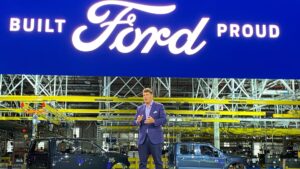The Unfolding Chaos in the U.S. Automotive Industry: Insights from Ford’s CEO
In an exclusive perspective shared during a recent Wolfe Research investment conference, Ford Motor Company’s CEO, Jim Farley, provided a stark assessment of the current state of the U.S. automotive industry. As the second-largest automaker in America, Ford is at the forefront of experiencing the tumultuous impact of President Donald Trump’s tariffs, which have created considerable disruption in the market.
The Impact of Tariffs on Automotive Costs
Farley articulated that the implementation of a 25% tariff on steel and aluminum, combined with additional threats of similar tariffs on imports from Mexico and Canada, adds "a lot of cost and a lot of chaos" to the automotive sector. This sentiment resonates deeply within the industry, as manufacturers wrestle with rising costs that could ultimately affect consumers and their bottom lines.
The realities of the situation are further underscored by the fact that while the majority of Ford’s steel and aluminum are sourced domestically, many suppliers still depend on international sources for these essential materials. This dependency raises concerns about profitability and operational efficiency as tariffs impact pricing structures.
Potential Consequences of Increased Tariffs
Farley specifically highlighted the looming threat of additional tariffs which, he stated, could be “devastating.” The January 1 deadline for potential duties that may be imposed on Mexican goods could “blow a hole in the U.S. industry that we’ve never seen,” making it a critical point of concern for Ford and its competitors alike.
This leads us to consider—what does this mean for the future of American manufacturing? With electric vehicles (EVs) rapidly gaining traction, Ford, like many others, is investing heavily in transitioning its fleet. The implications of tariffs extend beyond steel and aluminum; they trickle down to every component and might hinder the progress towards embracing sustainable solutions.
What Lies Ahead for the Automotive Sector?
As the automotive industry braces itself against impending tariffs, questions loom on strategic supply chain management, cost control, and pricing strategies. Companies might need to evaluate their sourcing practices and consider further investment in local suppliers to mitigate risk from global supply chain vulnerabilities.
At Extreme Investor Network, we believe that staying ahead of the curve requires businesses to be agile and responsive to these evolving challenges. Here are some strategies that could help automotive investors navigate this tumultuous landscape:
-
Diversify Supply Chains: Building relationships with a mix of domestic and international suppliers can help mitigate the risks associated with tariffs, ensuring a balanced approach to sourcing materials.
-
Invest in Technology: Incorporating cutting-edge technology and automation can help improve efficiency and reduce production costs, potentially offsetting increases due to tariffs.
-
Embrace Sustainability: With increasing consumer demand for eco-friendly vehicles, focusing on sustainable materials and practices can provide a competitive edge.
-
Monitor Legislative Changes: Keeping a close watch on government policies and potential shifts in trade agreements can enable companies to strategize and adapt more effectively.
- Engage Consumers: Transparent communication about price adjustments and shifts in sourcing practices will be crucial to maintain consumer trust and loyalty.
Conclusion
The challenges highlighted by Jim Farley are not only a wake-up call for Ford, but a signal to the entire U.S. automotive industry about the need for strategic foresight. At Extreme Investor Network, we commit to delivering expert insights and actionable strategies to help investors and businesses thrive amidst uncertainty. Stay tuned for more updates as we continue to analyze the evolving landscape of the automotive sector.
With this blog post, we aim to provide value beyond the basic news while equipping our readers with actionable insights tailored to the current state of the automotive industry.

